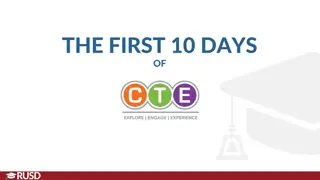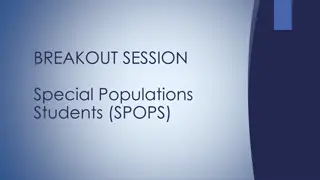Digital Communications Fundamentals and Applications in CTE Department 2018-2019
This content delves into the Digital Communications course in the CTE Department during the academic year 2018-2019. It covers topics such as Binary Amplitude Shift Keying (BASK), Generation and Detection of BASK, Differential Phase Shift Keying (DPSK), DPSK Generator, and the application of Digital Modulation Techniques in communication systems.
Download Presentation

Please find below an Image/Link to download the presentation.
The content on the website is provided AS IS for your information and personal use only. It may not be sold, licensed, or shared on other websites without obtaining consent from the author.If you encounter any issues during the download, it is possible that the publisher has removed the file from their server.
You are allowed to download the files provided on this website for personal or commercial use, subject to the condition that they are used lawfully. All files are the property of their respective owners.
The content on the website is provided AS IS for your information and personal use only. It may not be sold, licensed, or shared on other websites without obtaining consent from the author.
E N D
Presentation Transcript
. : 1- 2018-2019 Digital Communications CTE Department -3rdstage Reference: Digital Communications Fundamentalsand Applications, 2nd Addition, byFernardSklar Dr. Hussam Dheaa Kamel Al-Mustafa University Collage CTE Department 2018-2019
CTE Department -3rdstage Digital Communications 2- BinaryAmplitude Shift Keying (BASK) or ON- OFFkeying(OOK): ASK or OOK is the simplest digital modulation technique.TheASK waveform can be represented as: ?(?) = 2??cos(2??0?) to transmit symbol "1", and pulse is transmitted. To transmit symbol "0" ?(?) = 0, that is no signal transmitted for such symbol. ThusASK waveform looks like an ON-OFF of the signal as shown in figure 10. Figure10 The ASK wave form for symbol "1" can be represented as: ?(?) = ????. 2/??cos(2??0?) = ???? 1(?) 2
CTE Department -3rdstage Digital Communications Thus there is only one carrier function 1(?). If we take 1(?) = 2/??cos(2??0?) as the orthonormal basis function. The signal space diagram will have two points on 1(?). One will be at zero and other will be at ????. As shown in Fig.11: Figure11 Therefore the distance between the two signal points will be, ? = ????= ?? 3-1 Generation of BASK: Fig. 12 shows BASK generator. The input binary sequence is applied to the product modulator. The modulator passes the carrier when the input bits is "1", and block the carrier (zero output) when input bit is "0". Product Modulator Binary Inputs(t) BinaryASK signal s(t) ??????? 3 2??cos(2??0?)
CTE Department -3rdstage Digital Communications Figure12 The bandwidth of ASK is ?? = ?(1 +?) Where R is the bit rate and 0 < ? < 1 is related to how signal is filtered. 3-2 ASK Detector: The ASK signal is applied to the correlator consisting of multiplier and integrator. The locally generated coherent carrier and applied to multiplier as shown in Fig. 13. Figure13 4
CTE Department -3rdstage Digital Communications The output of multiplier is integrated over the bit period. The decision device takes the decision at the end of every bit period. It compare the output of integrator with the threshold. 3- Differential Phase Shift Keying (DPSK): DPSK is differentially coherent modulation method. It does not need synchronous (coherent) carrier at the demodulator. The input sequence of binary bits is modified such that the next bit depends upon the previous bit. Therefore in the receiver the previous received bits are used to detect the present bit. 4-1 Generator of DPSK: The input sequence d(t), the output sequence is b(t) and ?(? ??) is the previous output delayedby one bit period. Depending upon values of d(t) and ?(? ??), exclusive OR gate generates the output sequence b(t) as shown in Fig. 14. Figure 14: DPSKgenerator 5
CTE Department -3rdstage Digital Communications The truth table of exclusive OR gate is used to derive the level of waveforms shown in Fig. 15, which satisfied in any interval b(t) is given as, ?(?) = ?(?) ?(? ??) Figure 15: DPSK waveform Note that the output sequence b(t) changes level at the beginning of each interval in which d(t)=1 and does not change level when d(t)=0, so that symbol duration (T)= duration of two bits 2??. The sequence b(t) is applied to the balanced modulator as shown in Fig. 14 with carrier 2?cos(2??0?), the modulator output is: ?(?) = ?(?) 2? cos(2??0?) = 2? cos(2??0?) As shown in in Fig.15 the phase changes only when d(t)=1. 6
CTE Department -3rdstage Digital Communications 4-2 DPSK Receiver: During the transmission, the DPSK signal undergoes some phase shift ?. Therefore the signal received at the input of receiver is Received signal ?(?) = ?(?) 2? cos(2??0?+ ?) The signal is multiplied with delayed version by one bit: Multiplier output= ?(?)?(? ??)(2?) cos(2??0?+ ?) cos(2??0(? ??) + ?) Figure 16a: QPSK receiver This signal is fed to integrator and to the decision device. The integrator and decision is controlled by bit synchronizer to get the output binary sequence. The block diagram of such system is shown in Fig.16a, and the equivalent of this system is shown in Fig.16b. 7
CTE Department -3rdstage Digital Communications 4-3 Bandwidth of DPSK: We know that one previous bit is used to decide the phase shift of next bit. Change in b(t) occurs only if input bitt is at level '1'. No change occurs if input bit is at level '0'. Since one previous bit is always used to define the phase in next bit, the symbol can be said to have two bits.Therefore one symbol duration (T) is equivalent to two bits duration (2??), so that Symbol duration ? =2?? 2 1 Bandwidth is given as, ?? =?=?? Or ?? =?? 4-4 Advantages and disadvantages of DPSK: Advantages: 1- DPSK does not need carrier at its receiver. Hence it is simple than BPSK. 8
CTE Department -3rdstage Digital Communications 2- The bandwidth required of DPSK is reduced compared to that of BPSK. Disadvantages: 1 The probability of bit error rate of DPSK is higher than BPSK. 2 Error in the first bit creates error in the second bit. Hence error propagation in DPSK is more, while in PSK each bit is independent. 3 Noise interference in DPSK is more. 4 Quadrature Phase Shift Keying (QPSK): There are two important points in communication system, transmission power and channel bandwidth. The channel bandwidth depends upon the bit rate or signaling rate ??. The carrier is used as bandpass transmission over a channel. If two or more bits are combined in some symbol instead of one bit, then the signaling rate is reduced and the transmission channel bandwidth is reduced. In quadrature shift keying, two successive bits in the data sequence are grouped together. In BPSK the phase shift occurs in two level only, the carrier is change by 1800. In QPSK the combination of two bits form four distinct symbols, so that the change of carrier phase is 450 (????????) from one symbol to the next one. Table 1: Symbol and corresponding phase shift in QPSK Sr.No. Input successive bits Symbol 4 Phase shift in carrier ? = 1 1(1?) 0( 1?) ?1 ?/4 ? = 2 0( 1?) 0( 1?) ?2 3?/4 9
CTE Department -3rdstage Digital Communications ? =3 0( 1?) 1(1?) ?3 5?/4 ? =4 1(1?) 1(1?) ?4 7?/4 1 QPSK generator: There are two type of QPSK: 1 Offset QPSK (OQPSK): Fig. 17 shows the block diagram of OQPSK generator. The input signal is converted to NRZ and called b(t), the demultiplexer divides b(t) into separated bit streams of odd numbered and even numbered. 10
CTE Department -3rdstage Digital Communications Figure 17: OQPSK generator The symbol duration of both ??(?)and ??(?) are 2??as shown in Fig. 18. Note that the first symbol of ??(?) is delayed by one bit period with respect to symbol of ??(?). This delay of ??is called offset so that the change in level cannot occur in the same time. Each ??(?) and ?0(?) are modulate a carrier 2??sin(2??0?) and 2??cos(2??0?) respectivlly. 11
CTE Department -3rdstage Digital Communications 12
CTE Department -3rdstage Digital Communications ??(?) = ??(?) 2??sin(2??0?) ?0(?) = ?0(?) 2??sin(2??0?) Thus ??(?)and ?0(?) are basically BPSK signals but ? = 2??. The output of adder is OQPSK, givenas: ?(?) = ??(?) + ?0(?) 13
CTE Department -3rdstage Digital Communications =??(?) 2??sin(2??0?) + ?0(?) 2??cos(2??0?) Fig.19 shows the phasor diagram of QPSK signal of above equation. Figure 19: Phasor diagram of QPSKsignal 14
CTE Department -3rdstage Digital Communications Offset QPSK is essentially the same as QPSK except that the I- and Q-channel pulse trains are staggered. The modulator and the demodulator of OQPSK are shown in Figure 20, which differs from the QPSK only by an extra delay of T/2 seconds in the Q-channel. Its power spectral density is the same as that of QPSK, and its error performance is also the same as that of QPSK. Fig. 21: OQPSKmodulator 15
CTE Department -3rdstage Digital Communications Fig. 21: OQPSKdemodulator 16























